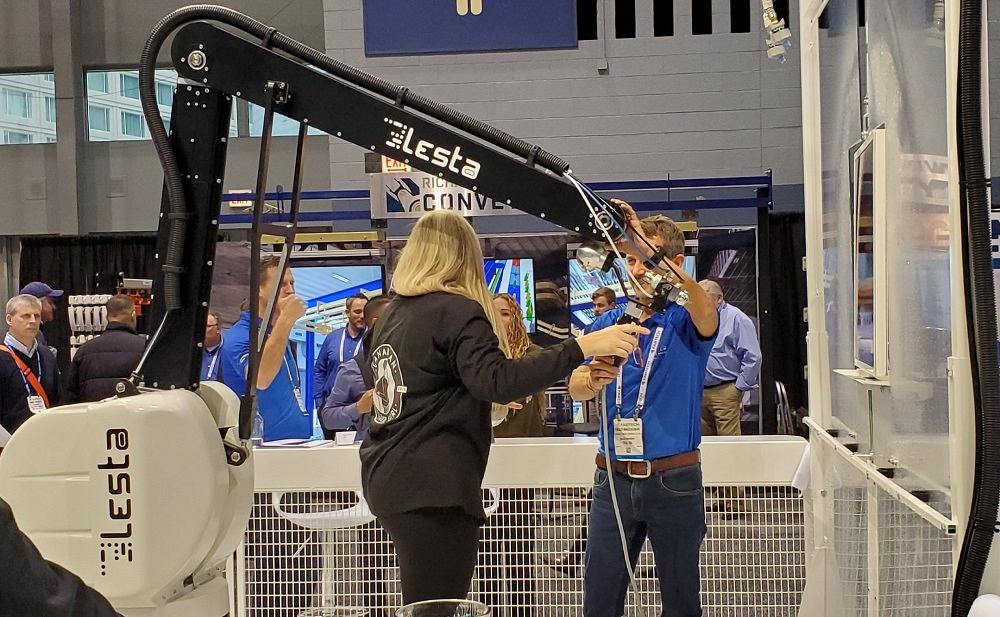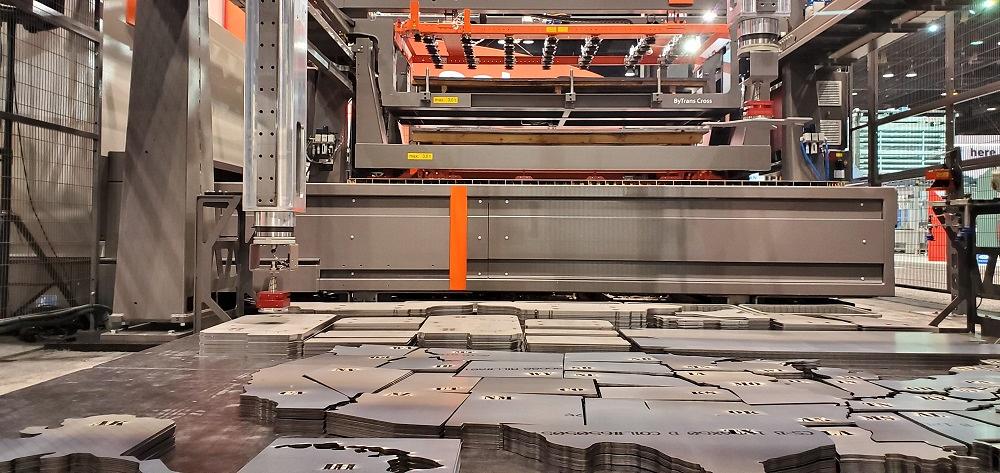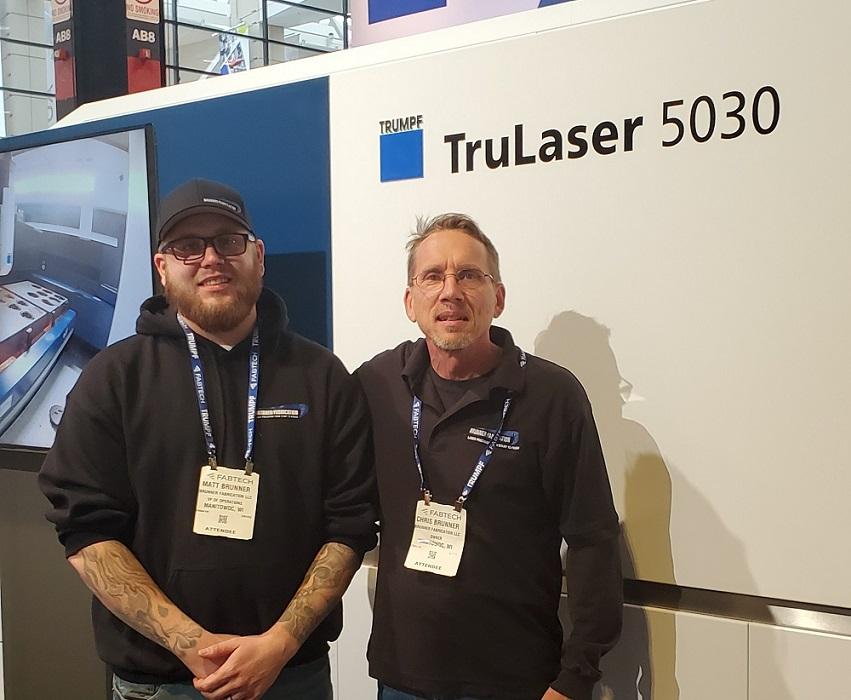Sr. Digital Editor
- FMA
- The Fabricator
- FABTECH
- Canadian Metalworking
Categories
- Additive Manufacturing
- Aluminum Welding
- Arc Welding
- Assembly and Joining
- Automation and Robotics
- Bending and Forming
- Consumables
- Cutting and Weld Prep
- Electric Vehicles
- En Español
- Finishing
- Hydroforming
- Laser Cutting
- Laser Welding
- Machining
- Manufacturing Software
- Materials Handling
- Metals/Materials
- Oxyfuel Cutting
- Plasma Cutting
- Power Tools
- Punching and Other Holemaking
- Roll Forming
- Safety
- Sawing
- Shearing
- Shop Management
- Testing and Measuring
- Tube and Pipe Fabrication
- Tube and Pipe Production
- Waterjet Cutting
Industry Directory
Webcasts
Podcasts
FAB 40
Advertise
Subscribe
Account Login
Search
FABTECH Days 2 and 3: LestaUSA revolutionizes robotic finishing; metal artist David Madero
Self-learning finishing technology, Bystronic's large-scale metal map turns heads at FABTECH
- By Gareth Sleger
- November 14, 2019

LetsaUSA officially launched during FABTECH 2019 and introduced its self-learning finishing technology. Gareth Sleger
Day 2 and Day 3 of FABTECH are in the books. The days were nonstop and chock-full of new products, seminars, training, panel discussions, and obsessive Fitbit checking. But here are a few things that stood out while walking the halls of McCormick Place on Tuesday and Wednesday.
Big reveal: LestaUSA launches with breakthrough finishing automation
This week at FABTECH, LestaUSA officially launched, forever changing the landscape of automated finishing across North American manufacturing and fabrication industries.
That might sound like hyperbole, but the self-learning finishing technology that LestaUSA is offering has never before been available in the United States.
It did, however, exist overseas, where Italian company Lesta began developing the technology in 2010. It just remained one of the industry’s best-kept secrets for the better part of the decade. That is until Tea, South Dakota-based DeGeest Steel Works, which has more than 40 years in metal fabrication, coating, welding, and, more recently, robotics, came across Lesta while researching options for automated finishing.
Needless to say, folks in the finishing and coating sectors visiting the LestaUSA FABTECH booth have been caught off guard with excitement. Visitors to the booth were also welcomed to try out the self-learning robot themselves.
"Even some of the equipment companies in the industry have come up and they're just like, 'Wow, what is this?’” said Derek DeGeest, president of DeGeest Steel Works and LestaUSA.
Here’s how Lesta’s self-learning technology works: An operator uses the weight-less finishing attachment to manually coat a part while the software records precise spray outputs, air ratios, and spray patterns. After that, the automation process kicks in and the robot coats part after part without any complicated programming.
"We thought that this was too good to be true,” said DeGeest. “So, we called [Lesta] up and said, 'Hey, what's the deal? I've never heard of this before. We know robots, and this can't be true.'"Before contacting Lesta, DeGeest hit roadblocks at every turn when trying to find an automated finishing solution.
"The problem was that we thought that it would be easy. We thought it would be just like a welding robot. Boy, were we wrong,” said DeGeest. “There are thousands of subtle decisions made by powder coaters and paint finishers that they don't even know they're doing. When you try to program that, it's just overwhelming."
The automated finishing options that were available stateside were only designed for industries like automotive, which used technology that had fixed programming to paint parts at massive volume. That simply wasn’t practicable – financially or operationally – for job shops like DeGeest, where procedures are frequently re-engineered to handle thousands of everchanging products and parts.

An operator uses the weight-less finishing attachment to manually coat a part while the software records precise spray outputs, air ratios, and spray patterns. Gareth Sleger
And when DeGeest asked around the finishing industry if what Lesta was offering was known in North America, no one knew about it. “I was blown away,” said DeGeest. “What happened? How has everyone missed this?”
So Lesta cofounder Emanuele Mazza flew DeGeest’s team to Europe and gave them tours of some of the 350 facilities that were using the self-learning coating technology.
“It was actually a good moment to meet each other,” said Mazza. “We were ready to open to other markets. It was our strategy to open in North America. We wanted to replicate the good success that we had [in Europe] and show what can be done with our solutions here. We were lucky because Derek and I met at the right moment.”
With that came the development of LestaUSA, which Derek DeGeest has been named president. LestaUSA is currently building a manufacturing facility that will produce, manufacture, and assemble self-learning robots in the U.S. But DeGeest also expects LestaUSA to be on the forefront of training everyone in the industry how it properly utilizes the technology.
“We want to be able to educate the market on how to use these robots and the industrial applications because no one's really done it before,” he said. “It isn't a magic bullet in itself. You still need to work with your local distributor, your paint or powder provider, and the equipment. We all have to work together to really create a successful system."
Metal art: David Madero puts on show at ESAB booth
David Madero’s partnership with ESAB seemed destined even before either party was fully aware of each other.
"I've been using Victor torches since I was a little kid,” said Madero, a Mexican-American metal artist and founder of welded-art company Madero/Co., Torreon, Mexico. “My father only used them. I used them not really having any idea about the brand."
It was just habit as he learned his artistic trade from his father Rogelio Madero at a young age. Madero’s father was a pioneer in the creating welding sculptures using oxy acetylene.
“My father was just a badass, old-school welder,” Madero said. “Not so many did what he did almost 70 years ago now.”
But as that habit and his father’s influence eventually grew into a successful metal sculpture career, Madero would tag Victor in social media posts. Then one day the tag didn’t work. He soon found out ESAB bought out Victor. And when Madero began tagging ESAB on social media posts, ESAB took notice and reached out to get the ball rolling on a partnership.
"I can't tell you how exciting this is,” Madero said. “This something I've been using for 30 years since I was 12 years old. To be around the people who designed the torches, make the torches – I can't believe I'm part of the team right now. It's mind-boggling."
While at FABTECH, Madero has been in ESAB’s booth working on a piece that incorporates the company’s “We Shape the Future” campaign. As with many of Madero’s work, the sculpture uses steel, brass, copper, and bronze to create an image of steps representing each decade of ESAB’s more than 110 years as a company, the ESAB logo, a floating welder, wind turbines, and skyscraper.
“I wanted it to be an elevated piece,” said Madero, who also travels internationally to give workshops in places like Japan, Italy, and Kazakhstan. “The welder is victorious and showing all the things he can do with a welding machine. And it’s pointing towards the future. I want people to understand that welding isn’t just industrial. You can do something creative and artistic with these torches.”
Madero plans to have the piece finished by the end of FABTECH, so watch him work and to see the final work of art, stop by ESAB’s booth at B17087.
Cool product: Bystronic’s robotic sorting system creates U.S. map
While walking down the line of 2100 booths in Hall A, you were likely slowed down by a crowd of people gathered around a portion of Bystronic’s massive show space. If you decided to walk around the huddle, here’s what you missed: an automated sorting system taking quarter-inch think pieces of metal cut into the shapes of every U.S. state and then placing them in precise order to create a large-scale map.
Cool, yes. But it’s also a creative way to show off Bystronic’s ByTrans Cross 3015 and BySort 3015, which have been in the market for about a year now but are making their FABTECH debut.
"What it shows is the true flexibility of the system because it's not cut like that. If you were to see the sheet when it was cut, the states are all turned and twisted,” said Robert St. Aubin, Bystronic’s President Market Division North America. “They're just laid out for best material utilization. But because of the intelligence and capability of the sorting system, it picks them up and brings them in and sets them down into the map structure."
What the system also addresses, like most automated processes, is the skilled labor shortage – even in part sorting.
"We have an old adage here that we kind of laugh about: What's the best thing about a fiber laser? It's fast. What's the worst thing about a fiber laser? It’s fast.” St. Aubin said.
Point is, as these fiber lasers continue to produce more and more parts at a faster pace, it then takes more and more workers to sort. And many shops don’t have the labor to keep up with the production.

Bystronic’s ByTrans Cross 3015 and BySort 3015 have been in the market for about a year now but are making their FABTECH debut. Gareth Sleger
“We understand that sorting those parts is the really next logical step in the value-added process,” St. Aubin added. “So, we came up with this [map] concept, and it’s really gone well.”
Pro tip: If you hang around the Bystronic booth when the fourth and final day of FABTECH ends (and the machines are shut down, of course), Bystronic staff members will open the gate surrounding the robotic sorter and allow attendees to take the metal-cut states as souvenirs.
Catching up: Wisconsin family fab shop expands TRUMPF partnership
Almost a year ago today, I wrote a story about how the Brunner family of Manitowoc, Wis., turned its auto body shop into a small metal fabrication shop. At the time, Matt and his father Chris were just a few months into their Brunner Fabrication Inc. venture with a used TRUMPF TruLaser 2030 from 2009 and a 5-foot CNC press brake crammed into a 40- by 50-ft. shop space.
But things have changed quite a bit in the past 12 months for the Brunners. I was lucky enough to meet up with Matt and Chris during their visit to FABTECH on Wednesday, and they caught me up to speed.
They have since expanded their shop space with a 55- by 85 ft. addition with extra ceiling height and upgraded their lighting system with energybank LED throughout.
The Brunners have also expanded their relationship with TRUMPF, purchasing a new TRUMPF TruLaser 5030 6kw fiber laser, LiftMaster Compact with PartMaster automation, and a brand new 6 axis, 40-inch, 40-ton TRUMPF 7036 Press Brake.
"I've been working with TRUMPF for seven, eight years at the other companies I worked for,” said Matt, “So I've had a good relationship with them. And we knew when we started, that's what we needed. TRUMPF's just on top of their game."
Peter Hoecklin, President at TRUMPF North America, even paid the Brunners a visit at their Manitowoc shop and have promoted they fab shop during TRUMPF-wide meetings. The two companies are also in talks about putting a TRUMPF logo on the outside of the Brunners’ facility.
“I think it's been amazing what they've been able to put together and what's happened over the last year," said Dave Dehrkoop of equipment sales rep company Maintecx Machine Tool, of which TRUMPF is its biggest supplier. "It speaks volumes to them as people and obviously also how they work with their customers. You don't get repeat business and have growth like that on accident.”
What’s next for the Brunners? Matt says just to keep prioritizing short lead times, something from Day 1 they made a key aspect of their business model.
“It’s the speed from quote to delivery,” said Matt.
Read about Day 1 of FABTECH 2019.
subscribe now

The Fabricator is North America's leading magazine for the metal forming and fabricating industry. The magazine delivers the news, technical articles, and case histories that enable fabricators to do their jobs more efficiently. The Fabricator has served the industry since 1970.
start your free subscriptionAbout the Author

- Stay connected from anywhere

Easily access valuable industry resources now with full access to the digital edition of The Fabricator.

Easily access valuable industry resources now with full access to the digital edition of The Welder.

Easily access valuable industry resources now with full access to the digital edition of The Tube and Pipe Journal.
- Podcasting
- Podcast:
- The Fabricator Podcast
- Published:
- 04/16/2024
- Running Time:
- 63:29
In this episode of The Fabricator Podcast, Caleb Chamberlain, co-founder and CEO of OSH Cut, discusses his company’s...
- Industry Events
16th Annual Safety Conference
- April 30 - May 1, 2024
- Elgin,
Pipe and Tube Conference
- May 21 - 22, 2024
- Omaha, NE
World-Class Roll Forming Workshop
- June 5 - 6, 2024
- Louisville, KY
Advanced Laser Application Workshop
- June 25 - 27, 2024
- Novi, MI

































